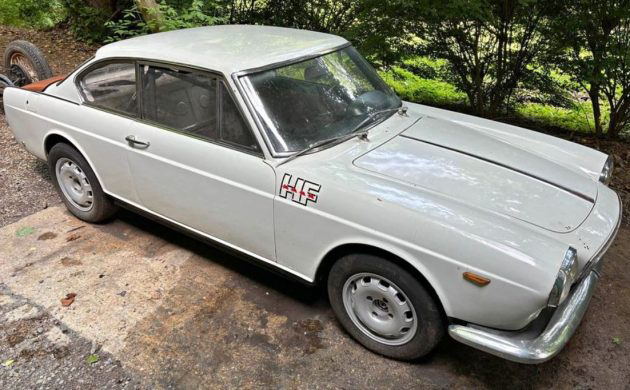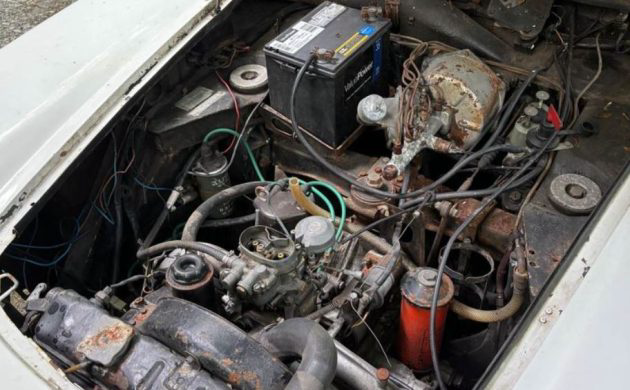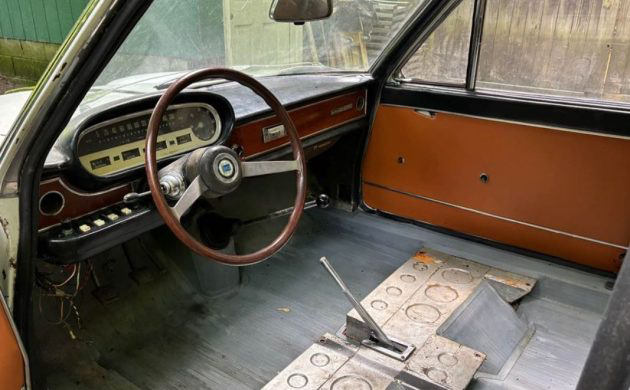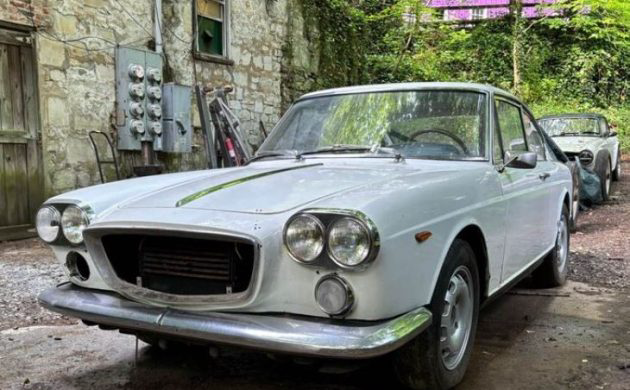Prominent on the flanks of the Lancia Flavia above are the initials “HF” – letters profoundly significant to Lancia, its history, and the Flavia coupé. Lancia was founded in 1906 by two racers, Vincenzo Lancia and Claudio Fogolin. Despite a keen interest in racing, the friends eschewed the track in favor of making innovative road cars as successfully as possible – cars like the Lambda, the Astura, and the Augusta – every one more elegant than the last. When Vincenzo died in 1937, his son Gianni stepped into his shoes. Gianni was captivated by racing and pushed Lancia towards the track, an impulse that culminated in the company’s first and only F1 entry, the D50. Driven by Alberto Ascari in one outing, the car’s brakes failed early, so revision was in the cards – until Ascari died driving a friend’s Ferrari in a practice session. The year was 1955, and Gianni Lancia, discouraged by Ascari’s passing and dogged by stretched finances at the company, sold his stake and left the business. Fast forward to 1960, and a group of Lancia’s most enthusiastic owners founded an association christened the “high fidelity” club, whose members had previously owned at least six Lancias. This association germinated a privateer racing team – HF Squadra Corse. Six Flavia coupés were entered in an inaugural outing, the Rallye dei Fiori. The results are beside the point, for this act kicked off Lancia’s racing accolades. To this day, no constructor has won more Manfucturer’s Championships than Lancia.
The Flavia was conceived shortly after Gianni sold the company to the Pesenti family. Vittorio Jano was out of a job as technical director in favor of the more practical Antonio Fessia. Requiring a car in the intermediate market segment, Lancia assigned Fessia the job, and Italy’s first front-wheel drive car was born. Fessia designed a boxer engine to achieve a compact dimension – two sets of opposing cylinders accompanied by a single carburetor – and placed it ahead of the front axle. A full synchromesh four-speed gearbox was installed behind the differential. For safety, the Flavia was designed with four-wheel disc brakes. Initial performance was less than sparkling: the 1500 cc engine generated only 79 hp and the journey to 60 mph was a lazy 19 seconds. By 1963, when our subject car was made, displacement had increased to 1800 ccs, improving its 0-60 time to fifteen seconds. This car was imported from Italy a decade ago, has its FIVA passport, and has taken part in numerous European rallies. It runs but requires fettling. Spares include a gearbox and engine, among other parts.
The interior is a work in progress but the seller says he has accumulated many parts to finish it off. Several of the car’s trim pieces have already been re-plated. The dash fascia and pad are new. Lancia was known for its classy approach to interior appointments – at least until Fiat acquired the company. This car would have high-grade cloth or vinyl seating surfaces and delicate aluminum interior handles. With the gearbox tucked up front, the cabin’s floor is spacious.
The Flavia arrived as a boxy sedan, designed in-house at Lancia. Pininfarina created the coupé in 1961, rounding its lines and creating an airy greenhouse. Rare in the United States, the coupé remains reasonably priced. This example – found for us by Jay L. – is listed on facebook Marketplace for $7700, and it’s located in Landenberg, Pennsylvania. Recent auction results show that buyers want to pay around $25k for a driving example, but sellers are asking more. Meanwhile, project cars can be far messier than this one. Despite the work involved, this example is worth its asking price.






Boxer engine. You had me until I read front wheel drive. Such a beautiful car deserves to be rear wheel drive and a manual transmission. And with the engine ahead of the drive axle, under steering must have been wicked.
Handsome car! I saw it and thought, “swap in an Iron Duke” or something that might fit in there. But FWD kinda puts the kibosh on that dream. Still, a darn good looking car!
Looks decent. Wish there were more photos of the car. Underside, rear, ect.
I still don’t get seeing rare cars on the same site folks sell lawn mowers and snow tires on.
This is a very interesting find that I really hope will find the right buyer. The price seems very reasonable, but that’s said without knowing what we don’t know. Is there bondo in the body panels? Rust around the subframe mounting points?
Generally these are lovely cars. Incredibly high quality builds (especially for people who mistakenly believe Italian cars to be cheap and fragile) but they are not sporty like the smaller Fulvia Coupe. The Flavia is more of a long distance Autostrada cruiser. Comparisons might be the Peugeot 404 Coupe or the Mercedes 250C.
The obvious risk here is for the car to fall into the hands of someone who doesn’t know what they are getting into. The Flavia is quite complex and parts are neither plentiful nor cheap.
A final side note that I don’t understand the comment about “the gearbox in the rear”? The Flavia has a fairly typical longitudinal FWD drivetrain package. For sure some cars such as the Renault 4 and the Citroen DS have the gearbox in front of the engine but that would be the unusual design and not this one..?
Geez, opposite of what I meant. Thx for the correction.
“This example – found for us by Jay L.”
Leno???
Well-researched write up, Michelle. It´s interesting how influential Cesare Fiorio was on Lancia in the 1960s, being the prime mover of the HiFi competition arm and then the works Lancia rally program. Beyfon has done a good analysis of this particular Flavia, so I´ll go into some of the background history.
Apologies to the true believers, but I´d say FIAT was responsible for what most remember these days as the glory years of Lancia competition (1970-1994 in rallies and sports prototypes). Not only did FIAT provide the money and mechanical bits for everything post-Fulvia (inc Stratos) but Abarth was re-purposed in the early1970s to develop the Lancia race/rally cars and run the teams.
I´ve sometimes felt that Lancisti who bemoan a drop in Lancia fittings and fixtures in the post-Fiat era look down the wrong end of the telescope. Personally, I´ve never rated cars on the quality of their ash trays and door furniture. Had Lancia not been rescued by FIAT in 1969, there wouldn´t be much to say even about the Fulvia, as the car´s most signifocant rally wins came late in its life and under FIAT ownership. No.one would remember Fulvia based on pre 1970 results alone – mainly upto 1.3 litre class wins.
The previous golden age for Lancia (1949-56) was presided over by a true genius, Vittorio Jano, the great Alfa engineer appointed by Vittorio Lancia before his death. Jano developed the Aurelia, Appia and the competition cars (D20, D24 and D50) which brought real glory to the company. Unfortunately Gianni Lancia´s financial control of his dash for glory bankrupted the company for the first time. Jano went on to Ferrari (much improving the Colombo V12 and designing the V6 Dino engines) after he was replaced at Lancia by Fessia as Technical Director.
Fessia´s output does not come close to that of Jano and in no way was Fessia more practical as a technical director! Ing Fessia was known to be obsessive and controlling as an engineer, wedded to the FWD/boxer concept he had been promoting since the early post war years (see CEMSA Caproni FII). Fessia´s main failings were to control costs, to over engineer and to fail to sell the units required to keep the company afloat. His Flaminia failed to sell in great numbers, the Flavia never sold the numbers it should have, especially after the (best of the Fessia bunch) Fulvia cannibalised Flavia sales.
Fessia was never interested in getting performance from his engines, believed that competition was a waste of time and did nothing to help Cesaré Fiorio promote the marque with the HiFi program. Discuss!
Martin Horrocks: Thanks for being the one who corrects the usual “all over the place” comments.
Great article, Michelle! Lots of valuable history here.
Lancia used to be the Italian Subaru – unconventional engineering with a soul and a penchant for rust.
I’ve always said Lancia used to be the Italian Mercedes, dedicated to superlative standards of engineering and build quality, even to a fault. To paraphrase a Jamie Kitman Automobile Magazine column from memory, “Lancia may be the only car maker to nearly go out of business, twice, for paying too much attention to quality.”
There’s an old saw illustrating how various sports car manufacturers would approach the matter of designing a bracket to attach some component to a car. MG would use an off-the-shelf tractor part with a variety of mismatched nuts and bolts. Fiat would use a strip of sheetmetal spot-welded to the chassis. Alfa Romeo would design a nice cast-alloy bracket. Lancia would design the component itself with integrated mounting tabs, eliminating any need for a separate bracket entirely.
This is the bit I struggle with. What is good automotive engineering? If it is over-complicated, overpriced, underpowered and underperforming, fails to sell in the required numbers but is well-constructed, is that really a good piece of work?
I like difference. I like Lancias and have owned a couple of really nice Fulvias but I do not buy into the myth of quality meets design in Lancia per se, particularly with the Fessia cars. Does bankrupting the company within 16 years of a fresh start speak of a successful trajectory?
Look at the photo of the Flavia engine bay. It´s a mess. Compare with any Alfa before or since! Why only one carb on an expensive GT (answer, ask the man who bought the 2 carb version how easy it was to keep in tune)? It´s the same with the Fulvia- lift the bonnet and there´s stuff scattered around everywhere. Sweet engine but marginal cooling -and what company which truly understood quality and value would specify Solex rather than Weber carbs in the 1960s?
I can’t speak for other Lancia owners but, my 1977 Beta Berlina was remarkedly rust free for the 12 years that I owned it despite the nasty winters of the Northeast and the salt laden highways. The fiberglass wheel well liners did much to keep the tin worm away.
The car had an interesting history which caused some confusion for the dealer as the s/n was out of sequence for USA spec cars. Turns out the car was one of several built for the Austrian market but, returned to the factory and refitted to USA specifications. It is unknown if these cars received additional corrosion protection at that time. Thanks to FAZA, some engine mods were made which improved performance and still passed state inspections.
Nice starting point
Excellent write up Michelle, and a particularly engaging comments thread!
Just a very minor nit, the flank of an automobile is between the B and C pillars, not in front of the A pillar.
fantastic. Even ges w/his house. He should get rid of his other 2’n go to wrk on this, a real prize.